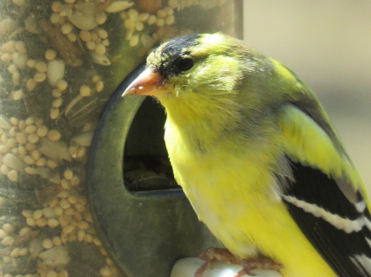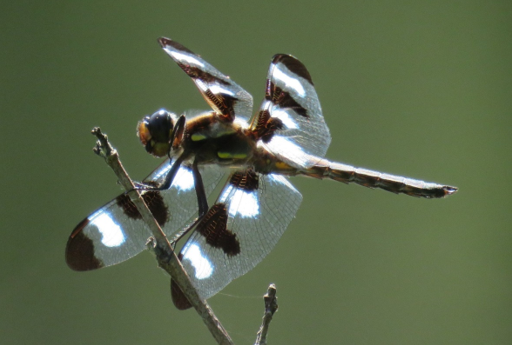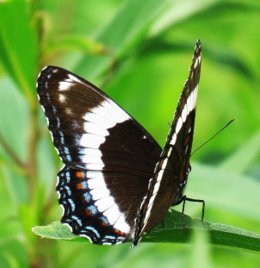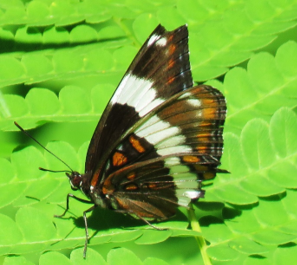Phenological Phacts and Photos w/ Carl Martland / August 2023
These Are a Few of My Favorite Wings
Phenology – “a branch of science concerned with the relationship between climate and periodic biological phenomena (as the migration of birds or the flowering and fruiting of plants).”
My Favorite Wings: Birds
When I was twelve, I had a chance to spend several weeks with my best friend and his family in an unusual campground on a hillside overlooking Narragansett Bay in Rhode Island. In my experience, and I expect also in yours, this campground was unique. But back in 1958, thousands of men my father’s age would have immediately recognized it, because it consisted solely of World War II surplus squad tents laid out evenly in rows on either side of a well-maintained, straight dirt road. Each tent had the shape of a pyramid atop a 16-foot square, and they were divided into three bedrooms and a kitchen by canvas hanging from cross beams. Each morning, Cap and I would pull up the shades, have breakfast, and follow a path for a half mile or so through a field, above rocky cliffs, eventually emerging at the end of Bonnet Shores, a private beach where we swam, body-surfed, played catch, and played various sorts of handball.
So how does this relate to an essay that is supposed to have something to do with phenology? Well, walking down to the beach day after day on that long ago but never forgotten summer, I saw my first goldfinch. I immediately recognized this bird, because it graced the cover of my first little bird book. Ever since, even though I rarely encountered goldfinches at home, whether in Rhode Island or Massachusetts, I have never failed to be amazed by this bird’s brilliant yellow body and its highly contrasting black cap and black wings.
Of course, now that we live in Sugar Hill, we have gold finches at the feeder in late winter, and we have them nesting in the Upper Meadow or flitting about the gardens throughout the summer. So, I think it quite appropriate to begin my list of “My favorite wings” with this bird that I have known and loved for nearly seventy years.
1 Photos and text by Carl D. Martland, founding member of ACT, long-time resident of Sugar Hill, and author of Sugar Hill Days: What’s Happening in the Fields, Wetlands, and Forests of a Small New Hampshire Town on the Western Edge of the White Mountain. Quotations from his book and his journals indicate the dates of and the situations depicted in the photos.
April 22, 2018, A male goldfinch has nearly come into his full courting plumage as it sits at our feeder.
Many birds have interesting wings, but to be included among my winged favorites, a bird requires something special. Evening grosbeaks certainly have lovely wings, but they are at best infrequent visitors, and their outsized beaks demand as much attention as their wings. The scarlet tanager has wings as delightful as the goldfinches – but when do you ever see one of them?
My second winged favorite, avian category, is therefore a well-known bird with proper phenological and behavioral characteristics. Known to authors of guidebooks as “redwinged blackbirds,” they are known to everyone else in New England as “redwings.” The first males are likely to show up while there is still snow on the ground:
March 22, 2023, 36 degrees, light clouds. The first redwing flew into the big spruce, its red patches brilliant in the morning sun! The ground is still 95% snow-covered and the pond is still iced over, but the ice is softening.
Within a week or so, the first female stops by, and soon flocks of redwings join their cousins foraging around the feeder:
April 4, 2023, cloudy, 11:00 to noon. Now that the females have arrived, the flock of blackbirds using our feeder has doubled in size. Today, there are at least seventy of them, including at least 30 redwings, 15 grackles, and a half dozen cowbirds.
The males then go to work establishing territories around the pond. These birds will eventually build nests in the cattails that line the pond, and a half-dozen or more are resident most summers. So, the males have two big tasks: first stake out and defend a territory and then attract a female. And this is where those red patches lined with a thin yellow stripe become important:
April 29, 2020, 42 degrees, sunny, beautiful! Two redwing blackbirds faced off high in the tops of two naked larch trees on the Point. They seemed to be working on boundary lines, as they fluttered about each other. Then they landed, one in each of the larch trees. The one in the highest perch looked down on the other and flashed its red stripes – take that! The other meekly sat still, showing only yellow and, after a silent minute or two, flew off.
By early June, redwings are busy feeding their hatchlings and chasing away me and any other intruders:
June 5, 2010. The redwings didn’t like my getting too close to their nests. First they called – “tsi – tsi- tsi – tsi” – from the tops of trees by the pond. Then they hovered over my head, still calling. Finally, they buzzed me.
When I walk out along the dam in July, I enjoy watching and listening to the proud males uttering their strange calls from the tops of the little clumps of willows and birches. They flash their reddest at me, not knowing that I merely want to see their colors, not to steal their babies. With luck, I have been able to get a couple of photos showing the angry male in flight.
June 3, 2015. An angry redwing almost flew into me as I walked along the dam.
My Favorite Wings: Dragonflies
If you sit by a pond on a sunny afternoon, you almost certainly see dragonflies patrolling the shoreline or resting on low vegetation near the shore. Many species have spots or splotches of color that are quite beautiful, but my two favorites are ones that a) I see every summer by the pond and b) frequently pose for a photo.
The 12-spotted skimmer is nearly three inches long, and the twelve black and white spots on each pair of wings make it one of the most photogenic dragonflies. Although I seldom find more than a couple around the pond at any given time, I usually see one or two of them at least once a week during mid-summer.
July 8, 2018, 85 degrees, nice breeze, perfect! The first D-Day skimmer flew by right as I was sitting on the frog bench starting this entry in my journal. Yes, I know it’s a 12-spotted skimmer, but I like to use the name that Nancy gave it twenty years ago. She said their wing stripes reminded her of the easily recognizable black and white stripes the allies painted on the wings and gliders that took part in the D-Day Invasion back in 1944.
July 9, 2022. 12-spotted skimmer perched on a twig at the edge of the pond.
The male widow skimmer, which is about the same size as the 12-spotted, also has black and white bands on its wings. Each male will define a territory perhaps a dozen yards long along the dam. He will fly back and forth a few times, then land for a minute or more just to see if any competitors might try to horn in. Unlike the 12-spotted, he is just as likely to land on wildflowers or grass as well as on twigs overhanging the pond.
Males of both species will aggressively defend their territories against other males, creating an exciting blur of color as they circle each other until one of them gives up and flies away.
July 16, 2019, 75 degrees, late morning, some sun, breeze, great day for me and the dragonflies! Two 12-spotted skimmers engaged in a long-lasting dog fight over the reeds, back and forth all along the dam. Perhaps like me, they’ve only seen one female 12-spotted this year. Two widow skimmer males also dogfighting along the dam, flying out over the dam and then in and out of the cattails.
July 9, 2019, 100pm, partly cloudy, warm, dry. I spent a happy hour and a half taking photos of insects, including a widow skimmer that repeatedly returned to pose on the top of the lupine after flying around its territory midway down the dam. Later, a 12-spotted skimmer flew in and out of the opening at our end of the pond.
I know that my fascination with dragonflies is unusual, and I am happy that my wife views this as one of my interesting eccentricities rather than an indication that I should seek professional help. Since this is an essay about “MY favorite wings,” it probably doesn’t matter whether or not she or my other readers will be familiar with MY selections. Perhaps my photos will encourage some to spend a few hours out by a pond some sunny afternoon in the hopes of seeing these skimmers. Good places to look include Coffin Pond, the pond by the parking lot for the trails in Bretzfelder Park, and the ponds you come across in the Sugar Hill Town Forest or the Scotland Brook Audubon Sanctuary in Landaff.
My Favorite Wings: Butterflies
As was the case with dragonflies, my favorite butterflies need to be common and willing to pose. I could include the monarch in this category, but then I would be highlighting what is likely the most popular butterfly in America. Instead, I’ll choose the silver-spotted skipper and the white admiral, two butterflies that are commonly seen on our lawn, by the pond, over our gardens and in the meadows.
There is a back story that makes the silver-spotted skipper one of my favorites. Back more than twenty years ago, I spent a couple of weeks painting the trim on our house, a task that involved a great deal of scraping. In order to keep bits of old paint out of the lawn, I would spread a drop cloth below the ladder before going to work. One day, when I came down, I was distressed to see that somehow flakes of old paint had ended up stuck on the wings of a poor butterfly. I regretted scraping right next to wet paint, and I hoped that I hadn’t doomed the poor creature. At least it was able to fly off. It was only days later, when I saw several more of these butterflies, that I realized what I had taken to be a paint chip was in fact an irregular white marking on the underside of its wings. These butterflies especially love to get nectar from Joe Pye Weed, and they usually sit with their wings up, thereby highlighting the white spots.
August 2, 2019, 80 degrees, sunny, not so humid. At 230, bullfrogs gave a brief rumbling chorus. Dragonflies and Damselflies are very active. I took photos of silver-spotted skippers and other butterflies on the Joe Pye Weed.
White admirals are large, dark butterflies easily identified by the contrasting white band across the top side of its wings. From a distance, they hardly look like a nominee for “My favorite wings.” However, up close, you can see brilliant blue and orange spots as well as variations on the dark blacks and browns. I have seen them as early as mid-April, but they are more commonly seen in mid-summer. Like the silver-spotted skipper, they love the Joe Pye Weed, and I often see both species in our large patch of this voluminous wildflower late summer.
July 3, 2020. White admiral, showing blues and oranges of wing tops.
July 8, 2019. White admiral, showing orange and bits of blues on the underside of its wings.
Keep your eyes open, and you may come across one or both of these butterflies when you walk through a field or along a rural road bordered by wildflowers. Maybe you’ll come across a different butterfly with even more beautiful colors that you could choose to be “one of YOUR favorite wings!”







